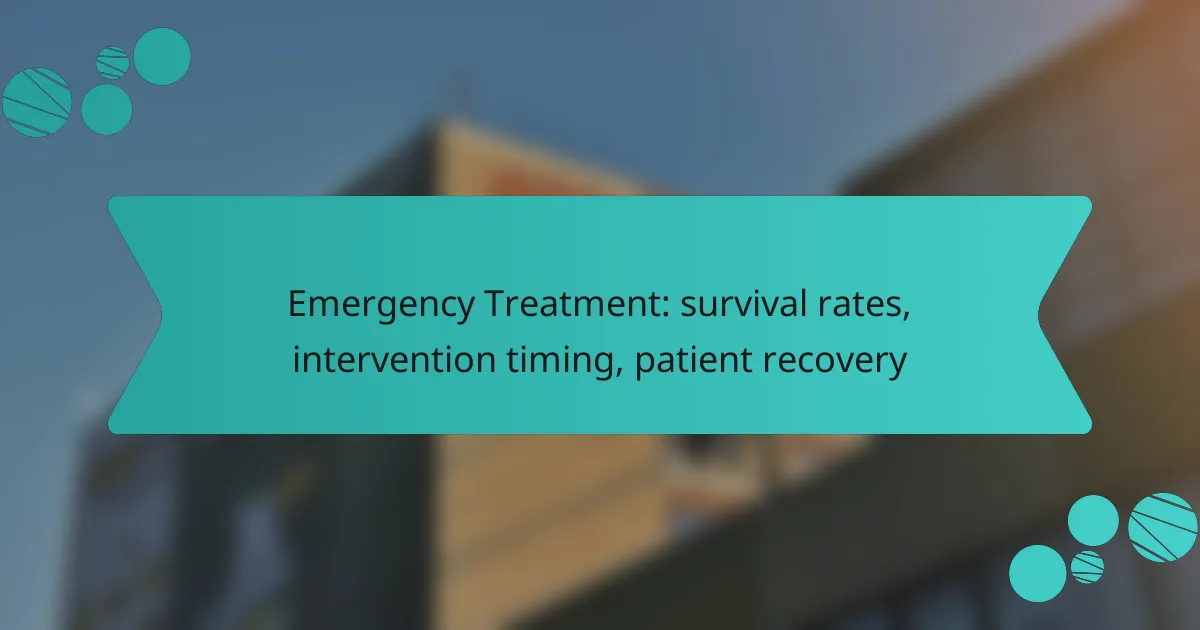Emergency treatment plays a vital role in stabilizing patients in critical conditions, with various life-saving interventions aimed at improving survival rates and recovery outcomes. The timing of these interventions is crucial, as quicker responses generally lead to better survival chances, highlighting the need for immediate action in emergencies. Understanding survival rates for different emergencies can inform the urgency of treatment and the effectiveness of emergency response systems.
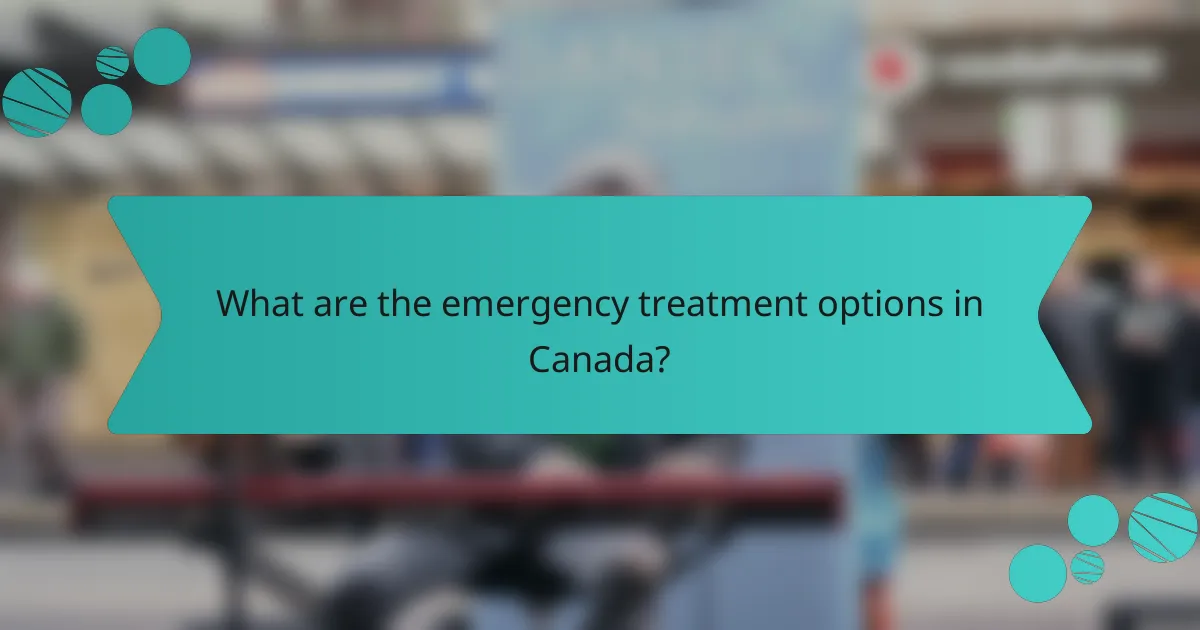
What are the emergency treatment options in Canada?
In Canada, emergency treatment options include various life-saving interventions designed to stabilize patients in critical conditions. These treatments aim to improve survival rates and enhance recovery outcomes through timely and effective medical responses.
Cardiopulmonary resuscitation (CPR)
Cardiopulmonary resuscitation (CPR) is a crucial emergency treatment used when a person’s heart stops beating. It involves chest compressions and rescue breaths to maintain blood flow and oxygenation until professional help arrives.
For effective CPR, compressions should be performed at a rate of 100 to 120 per minute, with a depth of about 5 to 6 centimeters. Bystanders are encouraged to start CPR immediately, as every minute without it can significantly decrease survival chances.
Defibrillation
Defibrillation is the use of an automated external defibrillator (AED) to restore a normal heart rhythm in cases of sudden cardiac arrest. This treatment is most effective when administered within minutes of collapse.
In Canada, AEDs are increasingly available in public spaces. It is vital to follow the device’s voice prompts and ensure that no one is touching the patient during the shock delivery. Early defibrillation can increase survival rates by over 50% when combined with CPR.
Advanced airway management
Advanced airway management involves securing the airway of a patient who is unable to breathe adequately on their own. This may include intubation or the use of other devices to ensure proper ventilation.
Healthcare providers must assess the patient’s condition quickly to determine the best method. Effective airway management is critical, especially in cases of trauma or respiratory failure, as it can prevent further complications and improve oxygen delivery to vital organs.
Intravenous medication administration
Intravenous (IV) medication administration is used to deliver medications directly into the bloodstream for rapid effect. This method is essential in emergencies where immediate drug action is required, such as in cases of anaphylaxis or severe pain.
Common medications administered via IV include epinephrine for allergic reactions and analgesics for pain relief. Proper training in IV techniques is crucial for emergency responders to avoid complications like infection or infiltration.
Trauma care interventions
Trauma care interventions focus on treating injuries resulting from accidents or violence. These interventions often include controlling bleeding, stabilizing fractures, and assessing for internal injuries.
In Canada, trauma care protocols emphasize rapid assessment and transport to specialized trauma centers when necessary. First responders should prioritize life-threatening conditions and follow established guidelines to ensure optimal patient outcomes.
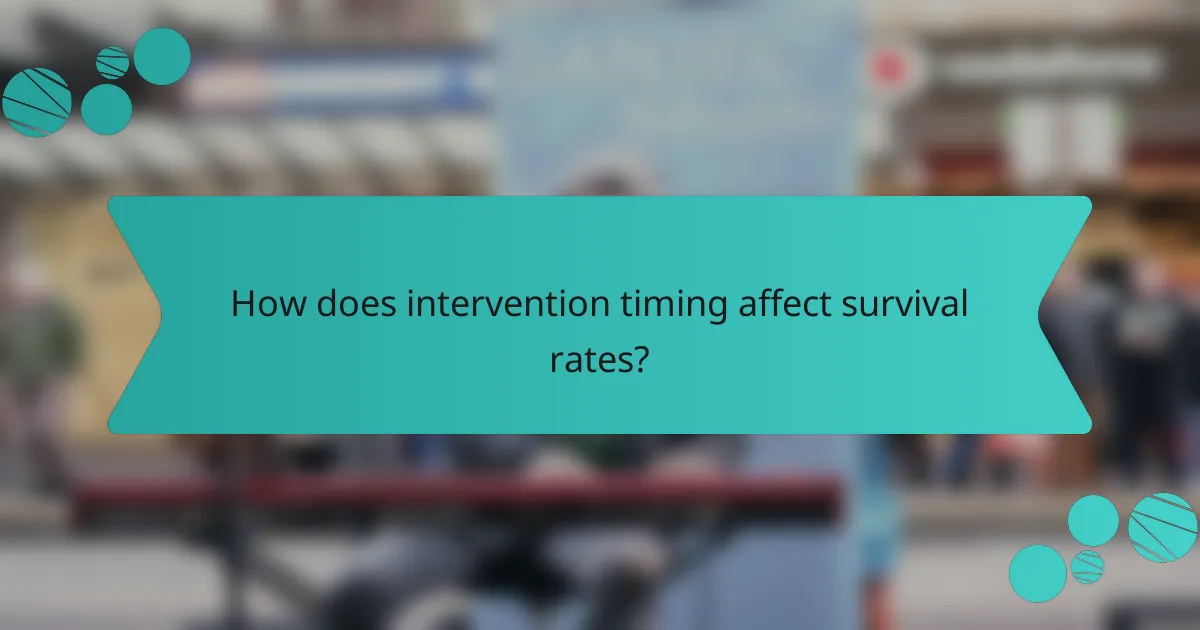
How does intervention timing affect survival rates?
Intervention timing is crucial in emergency treatment, as quicker responses typically lead to higher survival rates. Delays in treatment can significantly decrease the chances of recovery, emphasizing the importance of immediate action in critical situations.
Immediate intervention improves outcomes
Immediate intervention can drastically enhance patient outcomes by minimizing the effects of life-threatening conditions. For instance, in cases of cardiac arrest, initiating CPR within minutes can double or triple the likelihood of survival. The faster medical professionals can provide care, the better the prognosis for the patient.
Emergency responders should prioritize rapid assessment and treatment to stabilize patients. This includes administering necessary medications, performing life-saving procedures, and ensuring proper transport to medical facilities. Each second counts in these scenarios, and swift action can make a significant difference.
Golden hour significance
The “golden hour” refers to the critical first hour following a traumatic injury, where timely medical intervention is most likely to save lives. Research shows that patients receiving treatment within this window have notably higher survival rates compared to those treated later. This concept underscores the urgency of rapid response in emergencies.
To maximize the benefits of the golden hour, emergency teams should have protocols in place for quick transport and treatment. For example, hospitals often prepare for incoming trauma cases by mobilizing surgical teams and resources in advance. This proactive approach can greatly enhance patient recovery chances.
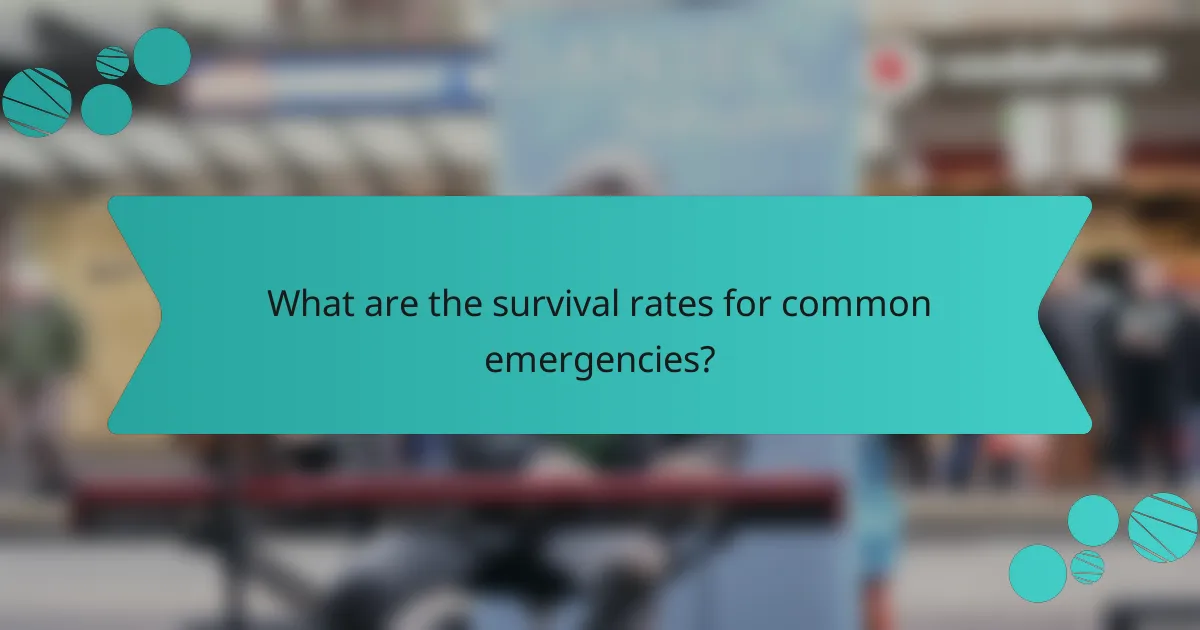
What are the survival rates for common emergencies?
Survival rates for common emergencies vary significantly based on the type of emergency, the speed of intervention, and the patient’s condition. Understanding these rates can help in assessing the urgency of treatment and the effectiveness of emergency response systems.
Cardiac arrest survival rates
Survival rates for cardiac arrest typically range from 10% to 20%, depending on factors such as the location of the arrest and the speed of CPR initiation. Immediate intervention, particularly the use of an automated external defibrillator (AED), can significantly improve outcomes.
For instance, survival rates can be higher in cases where bystanders perform CPR promptly and emergency services arrive quickly. Communities with robust public access to AEDs often report better survival statistics.
Stroke survival rates
Stroke survival rates can vary widely, with approximately 70% of stroke patients surviving the initial event, but long-term outcomes depend on the type of stroke and treatment received. Rapid access to medical care is crucial, as treatments like thrombolysis are most effective within a few hours of symptom onset.
Patients who receive treatment within the first three hours of a stroke typically have better recovery prospects. Awareness of stroke symptoms and the importance of immediate medical attention can greatly influence survival and recovery rates.
Trauma survival rates
Trauma survival rates generally hover around 90% for non-fatal injuries, but this can drop significantly for severe cases, such as traumatic brain injuries or major hemorrhaging. The timing of medical intervention plays a critical role in these statistics.
For example, trauma patients who receive care within the “golden hour” after injury are more likely to survive and recover fully. Effective trauma systems that ensure rapid transport and treatment can enhance survival rates significantly.
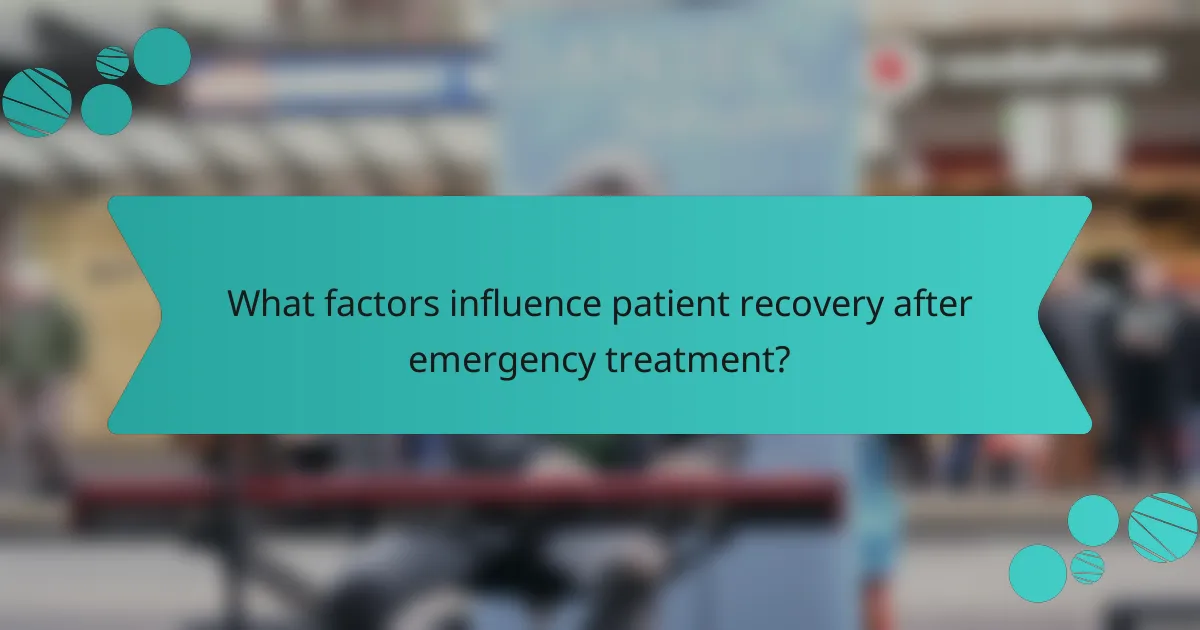
What factors influence patient recovery after emergency treatment?
Patient recovery after emergency treatment is influenced by several key factors, including age, overall health, the type of emergency, and the quality of initial care received. Understanding these elements can help in predicting outcomes and improving recovery rates.
Age and overall health
Age and overall health significantly impact recovery rates after emergency treatment. Generally, younger patients tend to recover more quickly than older individuals, who may have pre-existing health conditions that complicate recovery. For instance, a healthy 30-year-old may bounce back from a traumatic injury more effectively than a 70-year-old with chronic illnesses.
Additionally, factors such as nutrition, fitness level, and the presence of comorbidities play a crucial role. Patients with robust health and no underlying conditions typically experience better outcomes, while those with multiple health issues may face longer recovery times.
Type of emergency
The type of emergency directly affects recovery prospects. Life-threatening situations, such as cardiac arrest or severe trauma, require immediate intervention and can lead to varying recovery rates based on the severity of the condition. For example, a patient who receives timely treatment for a heart attack may have a significantly higher chance of survival compared to one who experiences a delay.
Different emergencies also necessitate different treatment protocols, which can influence recovery. For instance, stroke patients may benefit from rapid access to specialized care, improving their chances of regaining function.
Quality of initial care
The quality of initial care is critical in determining patient recovery. High-quality emergency care, characterized by quick assessment, appropriate interventions, and effective communication, can greatly enhance survival rates. For example, hospitals that adhere to established protocols for trauma care often see better outcomes than those that do not.
Moreover, the availability of resources, such as advanced medical equipment and trained personnel, can make a significant difference. Facilities that prioritize emergency preparedness and staff training are more likely to provide the level of care necessary for optimal recovery.
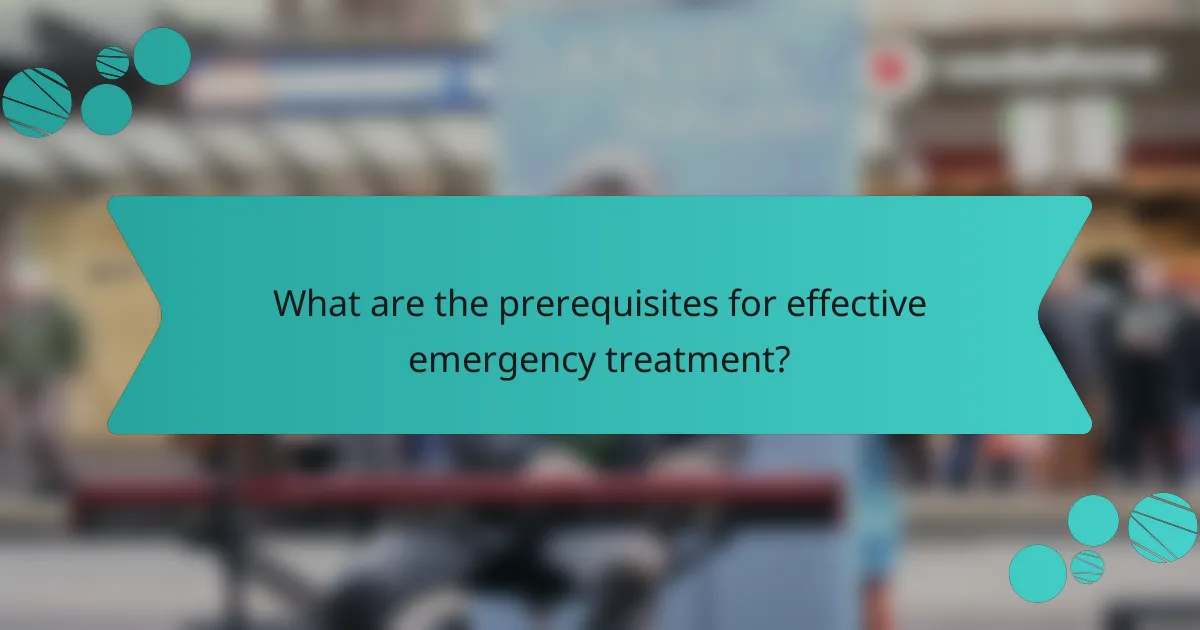
What are the prerequisites for effective emergency treatment?
Effective emergency treatment requires timely intervention, trained personnel, and accessible emergency services. These elements significantly influence patient survival rates and recovery outcomes.
Training for first responders
First responders must undergo rigorous training to handle various emergency situations effectively. This training typically includes CPR, first aid, and trauma care, ensuring they can act swiftly and appropriately.
Regular refresher courses and simulations help maintain skills and readiness. Communities should prioritize ongoing education to keep first responders updated on the latest techniques and protocols.
Access to emergency services
Quick access to emergency services is crucial for improving survival rates. This includes having well-marked emergency numbers and a reliable transportation system to hospitals.
In urban areas, response times can be as low as a few minutes, while rural locations may experience delays. Communities should assess their emergency service accessibility and invest in improvements where necessary.
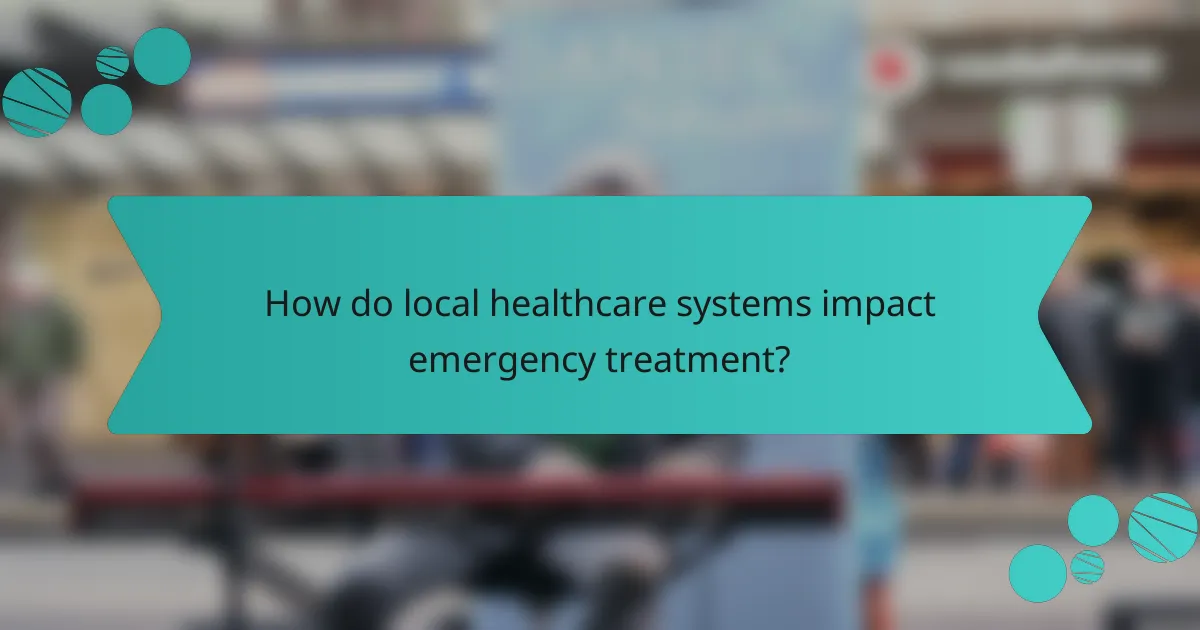
How do local healthcare systems impact emergency treatment?
Local healthcare systems significantly influence emergency treatment outcomes, including survival rates and recovery times. Factors such as resource availability, response times, and the overall infrastructure of healthcare facilities play crucial roles in determining the effectiveness of emergency interventions.
Availability of resources in urban vs rural areas
Urban areas typically have more healthcare resources, including hospitals, specialized medical staff, and advanced technology, which can lead to better emergency treatment outcomes. In contrast, rural areas may face limitations in these resources, resulting in longer travel times to reach care and potentially lower survival rates.
For example, a rural patient experiencing a heart attack may need to travel significant distances to access a facility equipped with advanced cardiac care. This delay can critically affect their chances of survival, highlighting the importance of resource distribution in emergency healthcare.
Response time variations
Response times for emergency services can vary widely between urban and rural settings. In urban areas, emergency responders often have quicker access to patients due to shorter distances and higher availability of ambulances, typically reaching patients within minutes. Conversely, rural emergency services may take longer to arrive, sometimes exceeding 20 minutes, which can be detrimental in time-sensitive situations.
Improving response times in rural areas can involve strategies such as establishing more local emergency stations or utilizing telemedicine for initial assessments. Communities can also benefit from training more individuals in basic life support to provide immediate assistance while waiting for professional help.
